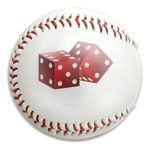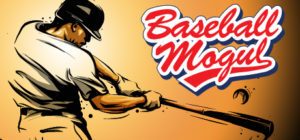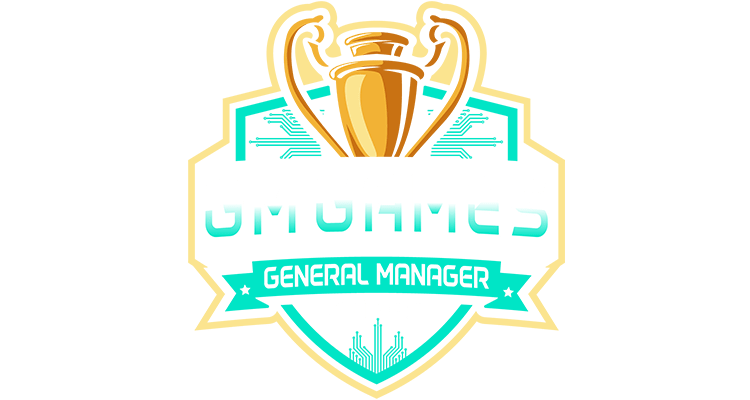Growing up in the 1950s, we did not have PlayStations, Nintendos, or Xboxes—no video games at all. We did not have 150 channels on cable or satellite TV or VHS movies or  DVDs. We had no surround sound or CDs, no cell phones, no personal computers, and no Internet. But we did have our imaginations, and we made up games. One game I played was dice baseball. In college in 1970, I programmed a baseball computer game based on my dice baseball game that has been accepted in the Baseball Hall of Fame as the oldest baseball game computer code. How did this journey happen?
DVDs. We had no surround sound or CDs, no cell phones, no personal computers, and no Internet. But we did have our imaginations, and we made up games. One game I played was dice baseball. In college in 1970, I programmed a baseball computer game based on my dice baseball game that has been accepted in the Baseball Hall of Fame as the oldest baseball game computer code. How did this journey happen?
When I was about ten years old, my cousin George introduced me to a game that involved rolling two dice; their combinations when tossed equated to hits, doubles, homers, or outs. I will always remember the dice combinations: two is a home run, three a double, four an out, and so on through twelve. The probabilities of the dice combinations with hits were comparable to a typical player’s season batting average. In my junior high school days, I played this game hundreds of times and began keeping cumulative statistics for batter and team records. I played a full thirty-two-game season with all the National League teams, and I even played an All-Star game after each team had played sixteen games by selecting the batters and pitchers with the best individual records.
I am convinced that the skills I learned from adding up batter’s records and calculating batting averages from my simple game prepared me for a business career that involves measures and metrics. It led to my authoring books and presenting seminars in over thirty international cities annually on how organizations can improve their performance. As a manager of performance management solutions at SAS, a world leader in business intelligence and analytics software, I observe incredible computer applications, ranging from biotech industry drug testing analysis to retailers forecasting line-item inventory for tens of thousands of shelf-items in hundreds, sometimes thousands, of stores.
From child’s play to game theory
During my junior year at Cornell University, I took a game theory course taught by Henry David Block, a famous professor who wrote computer chess games that played against  computerized chess games written by Russian professors. I majored in industrial engineering and operations research, which was a demanding curriculum on top of being a varsity football letterman.
computerized chess games written by Russian professors. I majored in industrial engineering and operations research, which was a demanding curriculum on top of being a varsity football letterman.
Professor Block, with his classic white Santa Claus beard, was an inspiration to me. His course, titled Bionics and Robots, was fun and less stressful than other engineering courses. For my term project in this course, I wrote a computer program using a programming language that was a blend of COBOL and FORTRAN—two “ancient” programming languages. The computer code applied a random number generator (in place of the two dice) for one hundred possible outcomes of batter hits that simulated every batter’s at-bat for the 1969 National League season. I still have the original hard-copy print-out on that big paper with the paper-feed holes—a true relic of the past. It was programmed on IBM punch cards that you had to walk to the data center to submit your card deck. This program’s deck of punch cards was a foot thick.
My classmate, Pete Watzka (who, coincidently, led the 1971 Ivy League baseball conference in batting average), calibrated each player to his 1969 batting average. Our computer program also differentiated batting power between single and home-run hitters, and for each game we adjusted the players “down or up” based on the quality of the opposing pitcher’s 1969 record.
Our computer program simulated all of the games played for each National League team. Pete and I enjoyed changing the input variables of players and pitchers and seeing how the outcomes changed each time we processed a computer run. On May 13, 1970, Pete and I submitted the “final” computer run for the course paper. The fun outcome of that run was that the team’s win-loss percentage records were very similar to their actual season records. The New York Mets won the league title. Rico Carty of the Atlanta Braves had a .340 batting average (compared to Carty’s actual .342 average), beating Pete Rose of the Cincinnati Reds for the batting title. Phil Niekro of the Atlanta Braves ranked as best pitcher with a 32-5 win-loss record. Willie Stargell of the Pittsburgh Pirates led in home runs with forty-four and edged out Willie McCovey of the San Francisco Giants for the Most Valuable Player award— the final equation in the computer program. Professor Block gave us an A, but the real pleasure was programming the code for the game.
The evolution of baseball computer games
Computer games have clearly become a big industry, and not just for kids— adults play them too. Over the years, computer baseball games have become increasingly sophisticated. For example, Sim Dynasty Baseball allows one to draft a fictitious franchise, set the rotation and lineup, groom prospects in the farm system, and make blockbuster trades. Three times a day, its custom designed Artificial Baseball Engine (affectionately named Abe) simulates the games and compiles complete box scores, play-by-play, and year-to-date statistics.

Another game, Baseball Mogul, puts the player in complete control of any professional baseball team. One can begin in any year you choose, from 1901 to 2008, with the full rosterof your favorite team—or an entirely fictional team of your own creation. You can negotiate trades and sign free agents to build a dynasty.
At the core of any computer sport game is the “spin of the dial” or “dice roll” that determines the next outcome. In the game that Pete and I created, a few lines of comport code brought the next batter to the plate and processed the random number generator that was cross-referenced to that at-bat outcome. Arguably, today’s baseball computer games evolved from that little kernel of computer code. You can imagine the thrill of now knowing what we did not realize at the time, that Pete and I were pioneers by developing that first computer code. Our accomplishment is obviously not on the same scale as the Wright brothers, but it is a great feeling.
The journey to the baseball hall of fame
I have been a member of the Society for American Baseball Research for over twenty-five years. A few years ago, after seeing so many computerized sports games in the marketplace, I posted a question on the SABR Web site asking whether anyone knew about the history of computerized baseball. I received a reply to contact the Baseball Hall of Fame.

MLB employees introduced me to James L. Gates Jr., the Library Director of the National Baseball Hall of Fame and Museum. He was invaluable in guiding me through the process of submitting the computer code and course paper Pete and I wrote to be judged whether it qualified as an artifact. It was accepted, and the Baseball Hall of Fame and Museum mailed me the official Deed of Gift that officially recognizes the computer code for baseball gaming purposes.
Pete Watzka and I are honored to have been early pioneers in creating computer code for baseball gaming. Little did I know as a youngster that dice baseball games would evolveinto an industry of computerized sports games, or that developing a computer program replicating my childhood pastime would influence my career in the application of automated information processing. I am now approaching sixty years old. Occasionally, I ask myself what legacy I want to be known for after I have passed on. Several of my options involve my business career. But having an accomplishment of mine archived in the Baseball Hall of Fame brings a smile to my face.

